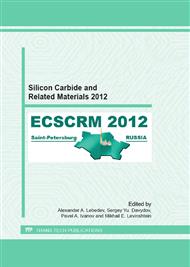[1]
H. Morkoc, S. Strite, G.B. Gao, M.E. Lin, B. Sverdlov, and M. Burns. Large-band-gap SiC, III-V nitride, and II-VI ZnSe-based semiconductor-device technologies, J. of Appl. Phys. 76(3) (1994) 1363–1398.
DOI: 10.1063/1.358463
Google Scholar
[2]
W. Lu and C.M. Lieber. Nanoelectronics from the bottom up, Nature Mat. 6 (2007).
Google Scholar
[3]
G. Attolini, F. Rossi, M. Bosi, B.E. Watts, and G. Salviati. Synthesis and characterization of 3C–SiC nanowires, J. of Non-Cryst. Sol. 354 (2008) 5227–5229.
DOI: 10.1016/j.jnoncrysol.2008.05.064
Google Scholar
[4]
J-S. Hyun, S-H. Nam, B-C. Kang, and J-H. Boo. Growth of 3C-SiC nanowires on nickel coated Si(100) substrate using dichloromethylvinylsilane and diethylmethylsilane by MOCVD method, Phys. Stat. Sol. C. 6(4) (2009) 810–812.
DOI: 10.1002/pssc.200880621
Google Scholar
[5]
L. Latu-Romain, M. Ollivier, A. Mantoux, G. Auvert, O. Chaix, E. Sarigiannidou, E. Bano, B. Pelissier, C. Roukoss, H. Roussel, F. Dhalluin, B. Salem, N. Jegenyes, G. Ferro, D. Chaussende, and T. Baron. From Si nanowire to SiC nanotubes, J. of Nanopart. Res. 13 (2011) 5425–5433.
DOI: 10.1007/s11051-011-0530-9
Google Scholar
[6]
M. Ollivier, L. Latu-Romain, A. Mantoux, E. Bano, and T. Baron. Carburization of Si microwires by chemical vapour deposition, J. of Nanosc. and Nanotech. 11(9) (2011) 8412–8415.
DOI: 10.1166/jnn.2011.5094
Google Scholar
[7]
K. Zekentes & K. Rogdakis, SiC nanowires: material and devices, J. of Phys. D: Appl. Phys. 44 (2011).
DOI: 10.1088/0022-3727/44/13/133001
Google Scholar
[8]
M Soueidan, G Ferro, B Nsouli, F Cauwet, J Dazord, G Younes, and Y Monteil. Effect of growth parameters on the heteroepitaxy of 3C-SiC on 6H-SiC substrate by chemical vapour deposition, Mat. Sci. and Eng. B – Sol. State Mat. for Adv. Tech. 130 (2006) 66–72.
DOI: 10.1016/j.mseb.2006.02.052
Google Scholar
[9]
G. Ferro, Y. Monteil, H. Vincent, F. Cauwet, J. Bouix, P. Durupt, J. Olivier, and R. Bisaro. Infrared kinetic study of ultrathin SiC buffer layers grown on Si( 100) by reactive chemical vapour deposition, Thin Solid Films, 278 (1996) 22–27.
DOI: 10.1016/0040-6090(95)08034-1
Google Scholar
[10]
V Cimalla, T Wohner, and J Pezoldt. The diffusion coefficient of silicon in thin SiC layers as a criterion for the quality of the grown layers, Sil. Carb. And Rel. Mat. 338-3 of Mat. Sci. For. (1999) 321–324.
DOI: 10.4028/www.scientific.net/msf.338-342.321
Google Scholar


